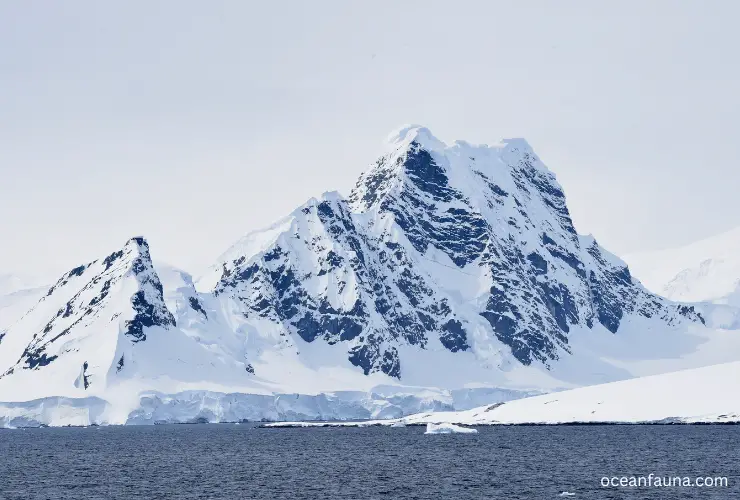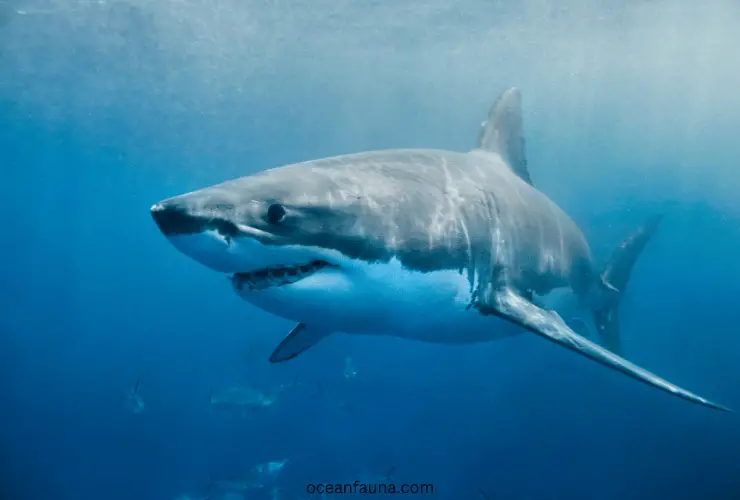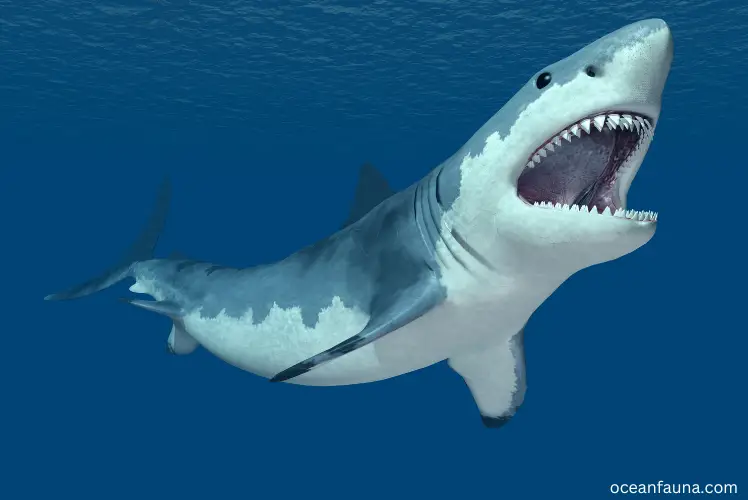If you’re asking are there sharks in Antarctica or not, the answer is no. However, if you’re asking if any species of shark is capable of surviving in Antarctica, the answer would be different. Does it sound interesting?
In this blog, I will explain why there are no sharks in Antarctica and provide information on which shark species can survive in the cold waters of the region.
Oceanic Geography of Antarctica
Before I tell you about whether or not there are sharks in Antarctica, you should have a good knowledge of the oceanic geography of Antarctica. The Southern Ocean is the only ocean in Antarctica. So it is also known as the Antarctic Ocean, which plays a critical role in the oceanic geography of Antarctica.
The oceanic division is vast, covering 20,327,000 km2, making it the second-smallest oceanic division in the world, larger only than the Arctic Ocean. However, it is one of the most critically important areas of the world ocean, encircling the continent of Antarctica and playing a crucial role in the regulation of global climate patterns.
One of the most significant features of the Southern Ocean is its water temperature, which ranges from -2 to 10°C or 28 to 50°F. The temperature variation between the ice and the ocean results in intense storms that tend to move eastwards around Antarctica.

The Southern Ocean’s unique location and oceanic conditions provide the ideal environment for some of the world’s most fascinating sea life.
Despite its vast size and significance, the Southern Ocean is often overlooked. However, it is worth noting that the oceanic division is home to some of the world’s most awe-inspiring marine creatures, including penguins, blue whales, orcas, colossal squids, and fur seals.
Notably, the emperor penguin is the only penguin that breeds during winter in Antarctica, while the Adélie penguin breeds further south than any other penguin.
Perhaps one of the most striking features of the Southern Ocean is the absence of shark species in the region. This fact is quite unusual, considering that sharks are typically found in almost every other oceanic division globally. The absence of shark species in the Southern Ocean can be attributed to the region’s unique geography and oceanic conditions.
In recent decades, the Southern Ocean has undergone significant changes as a result of rapid climate change. The changes have had significant effects on the marine ecosystem in the region. These changes necessitate the need for greater focus and attention on the Southern Ocean’s crucial role in the world oceanic division and its impact on global climate patterns.
Are There Sharks in Antarctica?
No, there are no sharks in the Southern Ocean around Antarctica. This may be surprising to some people, but it is a well-known fact that has been confirmed through various studies.
So, why is there no shark in Antarctica? The absence of sharks in Antarctica can be attributed to several factors discussed in detail below.
Temperature of the Water
The Southern Ocean around Antarctica is known for its freezing temperatures, which can go as low as -2°C. Sharks are cold-blooded animals, which means they cannot regulate their body temperature like warm-blooded animals. This makes them highly sensitive to changes in temperature, and they cannot survive in extremely cold waters. Therefore, the temperature of the water around Antarctica is a significant barrier to the presence of sharks.
Depth of the Ocean
The Southern Ocean around Antarctica is vast and deep, with an average depth of around 3,000 meters. Sharks are mostly found in shallow waters, and they prefer to stay near the surface where there is enough sunlight for them to hunt. The deep waters of the Southern Ocean are, therefore, unsuitable for the survival of sharks, as they cannot thrive in such an environment.
Lack of Prey
Sharks are carnivorous animals that feed on various sea creatures, such as fish, squid, and seals. The Southern Ocean around Antarctica has a very limited supply of prey, which means there is not enough food to sustain a population of sharks. Most of the marine life around Antarctica consists of krill and other small organisms that cannot support the predatory hunger of sharks.
Other Oceanic Geographical Factors
Apart from the above factors, other geographical factors may contribute to the absence of sharks in Antarctica. The strong currents around the Southern Ocean may make it difficult for sharks to navigate and find prey. The ice cover around Antarctica may also make it challenging for sharks to reach the surface where they can hunt for food.
Is There Any Shark That Can Survive in Antarctica?
You already know that there are no sharks in the frigid waters of the Southern Ocean. However, the Greenland shark is the exception. While not inhabiting the Southern Ocean specifically, the Greenland Shark is able to withstand the extreme coldness present in the waters of Antarctica.

The Greenland shark is a unique cold-water species that is found primarily in the North Atlantic and Arctic Oceans.
Interestingly, it is a species that has received very little scientific study, despite its potential importance in understanding the ecology of cold-water environments. This species is known to have the longest known lifespan of all vertebrate species, with some estimates suggesting that it may live for as long as 500 years.
Additionally, the Greenland Shark is among the largest extant species of shark, with some individuals measuring up to 22 feet in length and weighing over a ton.
Despite being capable of surviving in the cold waters surrounding Antarctica, the Greenland Shark is not found in these areas on a regular basis. This is likely due to the fact that they are adapted to the specific conditions present in the North Atlantic and Arctic Oceans and would not fare as well in the unique environment of the Southern Ocean.
Can Great White Sharks Live in Antarctica?
Great white sharks are known for their impressive size and fierce predatory behaviour. These large mackerel sharks are found in the coastal surface waters of all the major oceans around the world, and they are known to thrive in a variety of different environments and ecosystems.
However, one region where great white sharks are notably absent is the frigid waters surrounding the southernmost continent, Antarctica.
While it is true that great white sharks are found in the coastal waters of many different countries around the world, they tend to avoid areas where the water temperature is extremely cold.
The waters surrounding Antarctica are some of the coldest in the world, with temperatures frequently dropping below freezing. These conditions are simply not conducive to the survival of great white sharks, which require warmer waters to thrive.

Furthermore, the food web in Antarctica’s coastal waters is largely based around krill, small shrimp-like creatures that are not a part of the great white shark’s diet. Great whites typically feed on a variety of other marine animals, including fish, birds, and seals. Without access to these food sources, great white sharks would have difficulty surviving in the Antarctic region’s harsh conditions.
In fact, there are very few large predators that are able to survive in the waters surrounding Antarctica. The most notable exception is the orca, also known as the killer whale, which is an incredibly versatile and adaptable predator. Orcas are able to thrive in cold water environments and are a major part of the food web in the Southern Ocean.
FAQs
Can sharks survive in the Arctic?
Yes, several species of sharks can survive in the Arctic region. The arctic waters support a diverse population of marine life, including different species of sharks with unique adaptations that allow them to thrive in cold temperatures.
The porbeagle and Greenland sharks are two species that are particularly well-suited to the frigid Arctic waters. Both sharks have slow metabolic rates, which means they require less food and can conserve energy better than other shark species that are more active.
Additionally, they have insulating properties on their skin that help them retain warmth while swimming in cold water. Researchers have found that the Greenland shark has an antifreeze substance in its tissues that prevents the formation of ice crystals, allowing it to survive in cold water to freeze other marine animals.
The salmon shark and the spiny dogfish shark are two other species that can be found in the arctic ocean. The salmon shark is known for being one of the fastest-swimming shark species, and it has a high body temperature that helps it regulate its internal temperature in cold waters.
The spiny dogfish shark is also tolerant of the cold and can adjust its metabolism to cope with changing temperatures.
However, these shark species are facing threats in the Arctic region. Climate change is causing the Arctic Sea ice to melt at an alarming rate, affecting the entire ecosystem. Sharks are also being targeted by commercial fisheries, which has led to a decline in their populations.
Conservation efforts are necessary to protect these important apex predators and the delicate ecosystem they inhabit.
How cold is Antarctica’s bottom water?
Antarctic water has varying temperatures depending on the location. However, the Antarctic bottom water (AABW) that surrounds Antarctica has a temperature ranging from -0.8 to 2 °C (35 °F). This makes it one of the coldest water masses on the planet.
The AABW is formed due to the process of densification, where the water cools and sinks to the ocean floor due to increased salinity and the freezing of sea ice.
The water’s temperature is maintained by the constant influx of freshwater from ice melts, the movement of ocean currents, and the lack of sunlight in the Southern Ocean. These factors contribute to the AABW’s frigid temperature.
In addition to its low temperature, the absolute salinities of the AABW range from 34.6 to 35.0 g/kg, making it one of the saltiest water masses in the world. This high salinity is due to the formation of sea ice, which expels salt into the surrounding water, increasing its density and salinity.
The AABW plays a vital role in the global ocean circulation system, as it brings oxygen and nutrients to the deepest parts of the ocean, providing a habitat for various marine species. It also helps regulate the Earth’s climate by storing carbon dioxide in the deep ocean, reducing the levels of atmospheric CO2, which can contribute to global warming.
Conclusion
Hopefully, now you are clear that there are no sharks in Antarctica. The only shark that is capable of surviving in those extreme conditions is the Greenland shark. If you have any further questions about this, please let me know, and I will do my best to answer them promptly.

